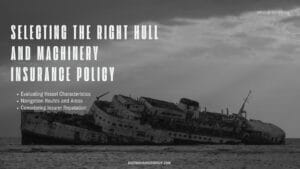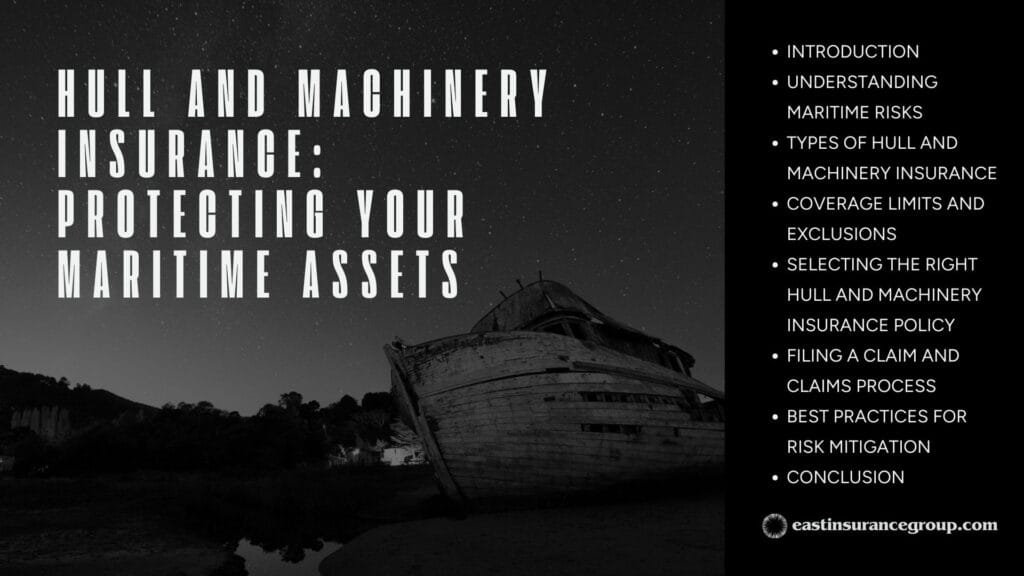Introduction
A. Definition of Hull and Machinery Insurance:
- Hull Insurance: Hull insurance is a type of marine insurance that provides coverage for physical damage to the hull and structure of a vessel. It protects against risks such as collisions, accidents, and other perils that can result in damage to the ship itself.
- Machinery Insurance: Machinery insurance, often included with hull insurance, covers damage to the vessel’s machinery and equipment. This includes the ship’s engines, propulsion systems, and other essential machinery.
B. Significance of Hull and Machinery Insurance for Maritime Assets:
- Financial Protection: Hull and machinery insurance offer financial protection to shipowners and operators by covering the costs associated with repairing or replacing a vessel in the event of physical damage.
- Risk Mitigation: Maritime assets face various risks, including collisions, grounding, and machinery breakdown. Hull and machinery insurance mitigate these risks, allowing businesses to operate with reduced financial uncertainty.
- Operational Continuity: In the maritime industry, the operational continuity of vessels is crucial. Hull and machinery insurance help ensure that, in the event of damage, vessels can be repaired or replaced promptly, minimizing downtime.
- Compliance with Lenders and International Regulations: Many lenders require vessels to have hull and machinery insurance as a condition for financing. Additionally, international regulations and conventions may mandate certain levels of insurance coverage for ships engaged in international trade.
- Safeguarding Investments: Maritime assets represent significant investments. Hull and machinery insurance safeguards these investments by providing a safety net against unforeseen events that could lead to substantial financial losses.
- Peace of Mind: Knowing that maritime assets are protected by insurance provides peace of mind to shipowners, operators, and stakeholders. It allows them to focus on their core operations without constant concern about the financial implications of unforeseen accidents or breakdowns.
In summary, hull and machinery insurance play a vital role in the maritime industry by providing financial protection, mitigating risks, ensuring operational continuity, and facilitating compliance with regulations. This insurance coverage is essential for safeguarding the significant investments associated with maritime assets.
Understanding Maritime Risks
A. Common Risks to Maritime Assets
- Physical Damage:
- Definition: Physical damage refers to harm or destruction caused to a vessel’s hull, structure, or equipment. This risk can arise from collisions, grounding, weather-related incidents, or other accidents during maritime operations.
- Insurance Coverage: Hull and machinery insurance provide coverage for the repair or replacement costs associated with physical damage to maritime assets.
- Machinery Breakdown:
- Definition: Machinery breakdown involves the failure or malfunction of critical components such as engines, propulsion systems, and onboard machinery. It can lead to operational disruptions and pose significant risks to the vessel’s functionality.
- Insurance Coverage: Machinery insurance, a component of hull and machinery insurance, covers the costs of repairing or replacing damaged machinery on the vessel.
- Collision and Contact Risks:
- Definition: Collisions and contact risks encompass accidents involving a vessel coming into contact with other ships, structures, or navigational hazards. These incidents can result in damage to the hull, machinery, or both.
- Insurance Coverage: Hull and machinery insurance address the financial consequences of collisions and contact risks, offering coverage for the repair or replacement of damaged components.
- Loss of Hire:
- Definition: Loss of hire refers to the financial losses incurred when a vessel is temporarily out of operation due to damage or repairs. During this period, the vessel may be unable to generate income for its owners or operators.
- Insurance Coverage: Loss of hire insurance provides compensation for the lost income during the period when the vessel is not operational due to covered risks.
B. Impact of Risks on Maritime Operations
Financial Consequences:
- Nature of Impact: The occurrence of risks such as physical damage, machinery breakdown, or collisions can lead to significant financial consequences. Repair or replacement costs, loss of income, and increased insurance premiums are among the financial impacts.
- Mitigation: Proper insurance coverage helps mitigate financial risks by providing funds for repairs, replacements, and compensating for lost income during downtime.
Operational Disruptions:
- Nature of Impact: Risks to maritime assets can cause operational disruptions, affecting schedules, routes, and overall efficiency. Machinery breakdowns or collisions may necessitate vessel repairs, resulting in downtime.
- Mitigation: Insurance coverage ensures that vessels can undergo timely repairs, minimizing operational disruptions and facilitating the swift return to regular maritime activities.
Reputational Damage:
- Nature of Impact: Incidents leading to physical damage or operational disruptions can harm the reputation of shipowners and operators. Reputational damage may affect relationships with clients, partners, and stakeholders.
- Mitigation: Swift and effective response to incidents, supported by insurance coverage, can help mitigate reputational damage. Communicating transparently about the measures taken to address risks is crucial.
Understanding these common risks and their potential impacts is essential for maritime stakeholders to implement effective risk management strategies and ensure the continued resilience of maritime operations.
Types of Hull and Machinery Insurance
A. Hull Insurance
- Coverage for Physical Damage to the Vessel:
- Scope of Coverage: Hull insurance provides coverage for physical damage to the hull and structure of a vessel. This includes damage caused by collisions, grounding, weather-related incidents, and other perils.
- Repair or Replacement: In the event of covered damage, the insurance policy covers the costs associated with repairing or replacing the damaged portions of the vessel.
- Total Loss vs. Partial Loss:
- Total Loss: In cases where the vessel sustains damage beyond a specified threshold, resulting in a total loss, the insurance covers the agreed-upon value of the vessel.
- Partial Loss: For damage that falls below the total loss threshold, the insurance covers the actual cost of repairs, considering factors such as depreciation and salvage value.
B. Machinery Insurance
- Coverage for Machinery Breakdown:
- Scope of Coverage: Machinery insurance focuses on covering the costs associated with the breakdown or damage to critical machinery and equipment on the vessel. This includes engines, propulsion systems, and other essential machinery.
- Operational Importance: Machinery breakdown can lead to operational delays, and machinery insurance is designed to mitigate these risks by providing coverage for repairs or replacements.
- Importance in Preventing Operational Delays:
- Downtime Impact: Machinery breakdowns can result in significant downtime for vessels, affecting operational schedules and income generation.
Timely Repairs: Machinery insurance plays a crucial role in preventing operational delays by ensuring that funds are available for timely repairs, allowing vessels to resume operations promptly.
C. Combined Hull and Machinery Insurance:
- Comprehensive Coverage for Both Physical Damage and Machinery Breakdown:
- Integrated Coverage: Combined hull and machinery insurance offer a comprehensive solution by integrating coverage for both physical damage to the vessel and machinery breakdown.
- Streamlined Protection: This type of insurance simplifies the coverage structure, providing a streamlined approach to safeguarding maritime assets against a range of risks.
- Holistic Risk Mitigation: By combining hull and machinery coverage, businesses benefit from a holistic risk mitigation strategy, addressing various perils that can impact both the structure and functionality of the vessel.
Understanding the distinctions between hull insurance, machinery insurance, and combined hull and machinery insurance enables maritime stakeholders to tailor their insurance coverage to the specific risks faced by their vessels, ensuring comprehensive protection against unforeseen events.
Coverage Limits and Exclusions
A. Determining Coverage Limits
- Vessel Valuation and Appraisal:
- Accurate Valuation: Determine coverage limits based on the accurate valuation of the vessel. This involves assessing its market value, age, condition, and any unique features.
- Appraisal Process: Consider professional vessel appraisals to ensure an unbiased and thorough assessment of the vessel’s value.
Consideration of Additional Costs: - Comprehensive Coverage: When determining coverage limits, account for additional costs beyond the vessel’s value. This includes expenses related to salvage, towing, environmental cleanup, and other incident-related costs.
- Avoiding Underinsurance: Adequate coverage limits help prevent the risk of being underinsured in the event of a claim.
B. Common Exclusions in Hull and Machinery Insurance:
Wear and Tear:
- Exclusion Rationale: Hull and machinery insurance typically exclude coverage for damage resulting from gradual wear and tear over time.
- Importance of Maintenance: Emphasize the importance of regular maintenance to minimize wear and tear-related risks.
Wilful Misconduct: - Exclusion Rationale: Insurance policies exclude coverage for damages caused by intentional, reckless, or negligent actions by the vessel’s owner, operators, or crew.
- Promoting Responsible Practices: Encourage responsible maritime practices to prevent incidents arising from wilful misconduct.
Nuclear Risks:
- Exclusion Rationale: Policies often exclude coverage for damages caused by nuclear events or radiation-related risks.
Specialized Coverage: Consider specialized insurance for nuclear risks if vessels operate in regions or conditions where this exclusion may pose a heightened risk.
War and Strikes:
- Exclusion Rationale: Insurance policies commonly exclude coverage for damages resulting from war, civil unrest, and strikes.
- Additional Coverage Considerations: Evaluate the need for additional coverage, such as war risk insurance, for vessels operating in regions prone to geopolitical instability.
Selecting the Right Hull and Machinery Insurance Policy

A. Evaluating Vessel Characteristics:
1. Age, Size, and Type of Vessel: Tailor insurance coverage to the specific characteristics of the vessel, considering factors such as age, size, and the type of vessel (cargo ship, tanker, passenger vessel, etc.).
2. Navigation Routes and Areas: Assess the geographical areas and routes where the vessel operates to ensure coverage aligns with the associated risks.
B. Assessing Machinery Risks:
1. Machinery Types and Complexity: Consider the complexity and types of machinery on the vessel. High-tech or specialized machinery may require specific coverage.
2. Maintenance Practices: Evaluate the vessel’s maintenance practices to assess the overall risk of machinery breakdown and the need for comprehensive coverage.
C. Considering Insurer Reputation:
1. Financial Stability: Choose insurers with proven financial stability to ensure their ability to meet claim obligations.
2. Claims Handling Track Record: Investigate the insurer’s track record in efficiently handling claims, providing transparency, and supporting clients throughout the claims process.
Filing a Claim and Claims Process
A. Notification to the Insurer
- Timely Reporting of Incidents: Immediately notify the insurer of any incidents or damages covered by the policy.
- Essential Information for Claims Initiation: Provide comprehensive information, including incident details, vessel identification, and preliminary assessments, to initiate the claims process.
B. Documentation and Investigation
- Inspection of Damage: Conduct a thorough inspection of the damage, documenting the extent and nature of the harm.
- Collaboration with Surveyors: Collaborate with independent surveyors to assess the damage objectively and provide detailed reports to support the claim.
C. Claim Settlement
- Negotiation and Agreement: Engage in transparent and collaborative negotiations with the insurer to reach a fair settlement agreement.
- Disbursement of Settlement: Once an agreement is reached, the insurer disburses the settlement amount promptly, facilitating the repair or replacement of the vessel.
Conclusion
A. Recap of Key Points
In summary, our exploration of hull and machinery insurance has covered critical considerations and practices vital for safeguarding maritime assets. We delved into understanding the risks, coverage types, policy limits, and the integration of insurance with risk management.
B. Emphasizing the Role of Hull and Machinery Insurance in Safeguarding Maritime Assets
The role of hull and machinery insurance is paramount in the maritime industry. It serves as a financial bulwark, mitigating the impact of unforeseen events on vessels and machinery. By providing comprehensive coverage, this insurance ensures the resilience of maritime operations, from routine voyages to navigating through unexpected challenges. The safeguarding of substantial investments, the guarantee of operational continuity, and the assurance of financial protection collectively highlight the indispensable role of hull and machinery insurance in preserving the integrity and prosperity of maritime assets. In a dynamic and sometimes unpredictable industry, this insurance stands as a stalwart guardian, offering peace of mind to maritime stakeholders.

